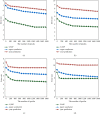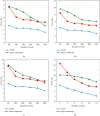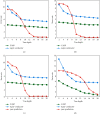Artificial Intelligence and Big Data Technologies in the Construction of Surgical Risk Prediction Model for Patients with Coronary Artery Bypass Grafting
- PMID: 37455771
- PMCID: PMC10348861
- DOI: 10.1155/2023/9575553
Artificial Intelligence and Big Data Technologies in the Construction of Surgical Risk Prediction Model for Patients with Coronary Artery Bypass Grafting
Abstract
The objective of this work was to predict the risk of mortality rate in patients with coronary artery bypass grafting (CABG) based on the risk prediction model of CABG using artificial intelligence (AI) and big data technologies. The clinical data of 2,364 patients undergoing CABG in our hospital from January 2019 to August 2021 were collected in this work. Based on AI and big data technology, business requirement analysis, system requirement analysis, complication prediction module, big data mining technology, and model building are carried out, respectively; the successful CABG risk prediction system includes case feature analysis service, risk warning service, and case retrieval service. The commonly used precision, recall, and F1-score were adopted to evaluate the quality of the gradient-boosted tree (GBT) model. The analysis proved that the GBT model was the best in terms of precision, F1-score, and area under the receiver operating characteristic curve (ROC). According to the CABG risk prediction model, 1,382 patients had a score of <0, 463 patients had a score of 0 ≤ score ≤ 2, 252 patients had a score of 2 < score ≤ 5, and 267 patients had a score of >5, which were stratified into four groups: A, B, C, and D. The actual number of in-hospital deaths was 25, and the in-hospital mortality rate was 1.05%. The mortality rate predicted by the CABG risk prediction model was 2.67 ± 1.82% (95% confidential interval (CI) (2.87-2.98)), which was higher than the actual value. The CABG risk prediction model showed the credible results only in group B with AUC = 0.763 > 0.7. In group B, 3 patients actually died, the actual mortality rate was 0.33%, and the predicted mortality rate was 0.96 ± 0.78 (95% CI (0.82-0.87)), which overestimated the mortality rate of patients in group B. It successfully constructed a CABG risk prediction model based on the AI and big data technologies, which would overestimate the mortality of patients with intermediate risk, and it is suitable for different types of heart diseases through continuous research and development and innovation, and provides clinical guidance value.
Copyright © 2023 Xiaoqiang Tang et al.
Conflict of interest statement
The authors declare that they have no conflicts of interest.
Figures










References
MeSH terms
LinkOut - more resources
Full Text Sources
Medical

